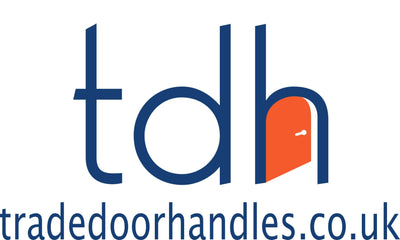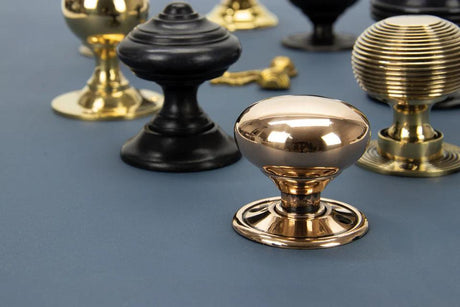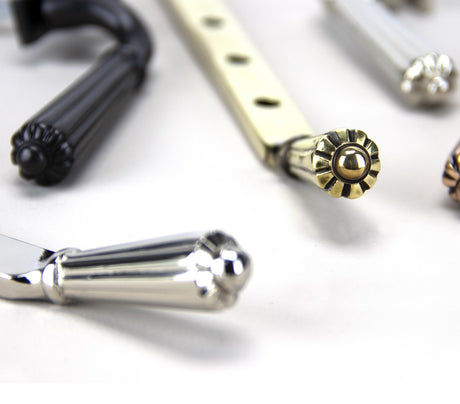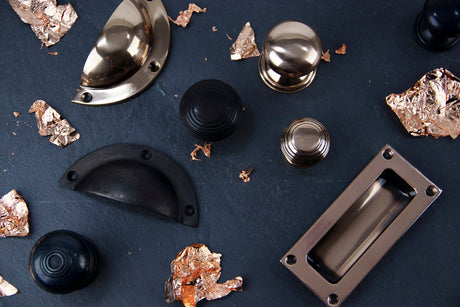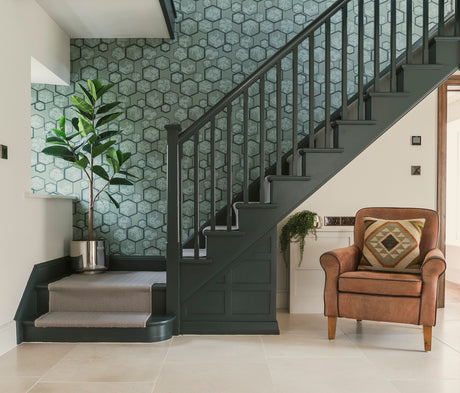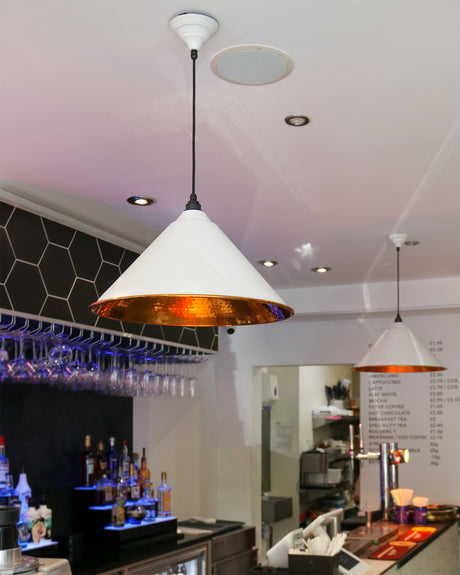Step-by-Step Guide to Measuring and Replacing Euro Profile Cylinders
When it comes to securing your home or property, understanding the components of your locking systems is essential. The Euro Profile Cylinder is one of the UK's most widely used locking mechanisms today. Known for their versatility, security, and adaptability, these locks have become the standard choice for residential and commercial doors.
At Trade Door Handles, we pride ourselves on being the Northwest’s largest supplier of architectural ironmongery, with decades of expertise in locks and door fittings. This guide is designed to help you understand Euro Profile Cylinders, how to measure them, and how to replace them confidently.
What Are Euro Profile Cylinders?
What is a Euro Cylinder?
Euro Profile Cylinders are a type of pin tumbler lock. Inside the cylinder are pins of varying lengths, aligning with the corresponding key's serrations to allow the lock to function. This mechanism ensures that only the correct key can engage the cam, the internal part of the cylinder that operates the locking bolt.
Euro cylinders are critical in multi-point locking systems and other types of sash locks and are commonly used on external doors, including UPVC, timber, and composite doors.
What is an Oval Cylinder?
An oval cylinder functions the same way as a Euro cylinder but features an oval shape rather than the characteristic Euro profile. These locks were once widely used in the UK but have become less common. Today, oval cylinders are more challenging to find and replace due to the limited availability of compatible mortice locks and hardware.
Differences Between Euro and Oval Cylinders
The primary difference between these two types of cylinders is their shape. Over the years, Euro cylinders have gained popularity thanks to their standardized design and compatibility with modern hardware. Oval cylinders, by contrast, are being phased out by manufacturers, making them increasingly difficult to source.
Essential Components for Using Euro Profile Cylinders
You’ll need more than just the cylinder when installing or replacing Euro Profile Cylinders. Key components include:
- A Mortice Lock Case: This houses and secures the cylinder within the door. It could be a sash lock, deadlock, Multi-Point Locking System or a DIN lock.
- Door Handles or Escutcheons: These must have the correct cutout to accommodate a Euro or oval profile.
Can You Switch from an Oval Profile to a Euro Profile?
If your current door setup uses an oval cylinder, you may want to upgrade to a Euro profile for better availability and improved security options. However, transitioning from oval to Euro isn’t a simple swap. You’ll need to:
- Replace the mortice lock case.
- Install Euro-compatible door handles or escutcheons.
- Choose a suitable Euro cylinder.
While this upgrade may involve additional costs, it’s an investment worth considering during renovations or security improvements.
How to Replace a Euro or Oval Cylinder
Tools You’ll Need
Replacing a cylinder requires only a few essential tools:
- A screwdriver.
- A tape measure or ruler.
- Your new cylinder.
Step-by-Step Instructions
- Open the Door: Look at the edge to locate the cylinder.
- Remove the Retaining Screw: Find and unscrew the bolt that holds the cylinder in place. This is usually in line with the bottom of the cylinder. This is sometimes hidden behind the lock faceplate.
- Align the Cam Tongue: Insert the key into the lock and turn it slightly to align the cam with the lock body.
- Extract the Cylinder: While turning the key, gently push or pull the cylinder out.
- Measure the Cylinder: Once removed, measure the size needed for replacement.
How to Measure for a Replacement Euro Profile Cylinder
Euro Profile Cylinders and oval cylinders are manufactured in various lengths to accommodate different door thicknesses and the positioning of the mortice lock case within the door. Accurate measurements ensure proper installation, security, and smooth operation.
Below is a handy diagram to help visualize the measuring process. This illustration outlines the key dimensions you need to take when measuring for a replacement cylinder.
Steps to Measure Your Cylinder
-
Measure Dimension A
- With the cylinder removed from the door, measure from the edge of the cylinder to the centre of the fixing screw hole.
-
Measure Dimension B
- Repeat the process on the opposite side of the cylinder, measuring from the edge to the centre of the fixing screw hole.
-
Measure Dimension C
- Add dimensions A and B together to determine the total cylinder length. This length is critical to ensuring your new cylinder fits correctly within the door hardware.
Important Note: Not all cylinders are equal in length on both sides. For example, you may have an offset cylinder with measurements like 40mm on one side and 50mm on the other, giving a total length of 90mm.
Example: Measuring From the Central Screw Hole
- Remove the cylinder from your door.
- Locate the central fixing screw hole on the cylinder.
- Measure from the center of this hole to the edge of the cylinder on one side (Dimension A).
- Measure from the same center point to the opposite edge (Dimension B).
The total length of the cylinder (Dimension C) is the sum of A and B. For example:
- A cylinder marked as "40/40" has equal dimensions of 40mm on both sides, giving a total length of 80mm.
- Cylinders with offset measurements might be marked "55/35," indicating a total length of 90mm with differing sides.
Refer to the Diagram Below for Clarity
To make the measuring process even simpler, we’ve included a detailed diagram below. The diagram clearly labels Dimensions A, B, and C, showing exactly where to measure and how these dimensions relate to the overall cylinder length. Use this as a reference to ensure you get the perfect fit for your door.
Typical Cylinder Sizes Based on Door Types
-
External Timber Doors :
Timber doors are commonly 44mm thick. Accounting for the thickness of the door handles or escutcheons (typically 10mm on each side), you’ll need a cylinder at least 64mm long. The closest size available generally is 70mm (split 35/35mm). -
Internal Timber Doors :
Internal timber doors are usually thinner, around 35mm thick. Adding the 10mm thickness of handles or escutcheons on either side, the minimum required cylinder length is 55mm. The nearest available size is 60mm (split 30/30mm). -
UPVC or Composite Doors :
These doors often feature not centred locks, meaning the cylinder will have an offset cam. For example, you might need a cylinder with a total length of 90mm, but the measurements could be uneven, such as 55mm on one side and 35mm on the other.
Why Accurate Measurement is Critical
If your cylinder is too short, it won’t sit flush with the handle, leaving it vulnerable to forced entry. It will protrude awkwardly if it’s too long, compromising security and appearance.
For a more precise visual understanding, refer to our detailed diagrams or seek guidance from our experts at Trade Door Handles.
How Many Cylinder Options Does Trade Door Handles Offer?
At Trade Door Handles, we pride ourselves on offering a wide range of Euro Profile Cylinders to meet the diverse needs of our customers. From standard options to high-security models, we have solutions for every door type and budget. If you're unsure about which cylinder is right for you, our expert team is just a phone call away at 01539 727000.
Before choosing a replacement cylinder, here are the key factors to consider:
- Size
- Finish
- Security
- Budget
- Configuration: Keyed both sides or key-and-turn.
- Keying Options: Standard, keyed alike, or master key systems.
Size
Accurately measuring your cylinder is crucial for a perfect fit. We’ve already covered how to remove and measure a cylinder, but if you have any doubts, please call us for guidance. A correctly sized cylinder ensures both functionality and security for your door.
Finish
Gone are when cylinders only came in standard silver or brass finishes. Today, cylinder finishes have evolved to complement modern door hardware designs, allowing homeowners to achieve a cohesive look.
Popular finishes for 2024 include:
- Matt Black
- Antique Brass
- Satin Brass
It’s important to note that most door handle manufacturers do not produce matching cylinders. While a precise match might not always be possible, choosing a complementary finish can enhance your door's aesthetic. For instance, pairing a black cylinder with black handles creates a sleek, modern look—far better than the outdated combination of silver cylinders with antique black handles.
Security
Security is arguably the most critical factor when selecting a Euro Profile Cylinder, yet it’s often overlooked. The cylinder is the heart of your door’s locking mechanism, and its security level determines how well your property is protected.
Key Security Features
-
Number of Pins
- Euro cylinders typically come with 5 or 6 pins.
- A 6-pin lock is more secure than a 5-pin lock, as the increased number of pins makes it harder to pick or manipulate.
-
Pin Lengths
- Each pin in a Euro cylinder lock is set to a different height.
- The key blade has unique indents that align these pins to the correct positions, allowing the cam to engage and operate the lock.
Enhanced Security Options
While standard Euro cylinders offer essential protection, they can be vulnerable to specific attacks. Thankfully, modern technology has introduced advanced features that significantly enhance security.
Here are some key security upgrades to look for:
-
Anti-Snap:
These cylinders feature a sacrificial line that breaks under force. While the external part of the cylinder snaps off, the internal locking cam remains intact, preventing entry. This feature is particularly effective against the "blowtorch technique," where the surrounding door material is melted to expose the lock. -
Anti-Pick:
Specially designed pins within the cylinder make picking extremely difficult, thwarting standard burglar techniques. -
Anti-Drill:
Hardened materials protect the lock against drilling attempts, ensuring the internal mechanism remains secure even under attack. -
TS007 3-Star Rating:
The TS007 rating is the gold standard for lock security. A 3-star rating signifies that the cylinder has been rigorously tested to withstand snapping, picking, drilling, bumping, and other forms of attack. -
BSI Kitemark or Sold Secure Rating:
These certifications indicate that a product has been tested to meet the highest quality and security standards.

Insurance Compliance
Many insurance providers have specific requirements for door locks. Typically, they require either:
- A minimum of a 1-star Euro cylinder combined with 2-star handles or escutcheons (though these can be hard to source in the UK).
- A 3-star BSI kitemarked cylinder.
Opting for a 3-star cylinder is the simplest way to ensure compliance. This level of security provides peace of mind, knowing that your lock has been designed to resist the most common break-in techniques.
How Easy Is It to Break Into a Cylinder?
Budget Euro Profile Cylinders and oval cylinders are vulnerable to various attack methods, some of which can compromise the lock in as little as 5–10 seconds. Here are the most common techniques burglars use:
Snapping the Cylinder: This involves applying force to break the front portion of the cylinder, exposing the internal locking mechanism. Once exposed, the mechanism can be manipulated with a screwdriver to unlock the door.
Plug Extraction: By inserting and tightening a screw into the keyway, the plug (the rotating core of the cylinder) can be forcibly pulled out using a claw hammer or similar tool. This exposes the lock mechanism and provides direct access.
Lock Bumping: Using a specially cut "bump key" and a hammer or similar tool, intruders can momentarily align all the internal pins in the lock, allowing the key to turn. This technique can be executed in seconds with the right tools and practice.
These vulnerabilities are particularly common in low-cost cylinders. However, they can be mitigated by investing in high-security Euro Profile Cylinders with features like anti-snap, anti-drill, and anti-pick mechanisms. Spending slightly more on a premium cylinder can significantly enhance your door’s security and deter potential intruders.
Budget Considerations
The price of a Euro Profile Cylinder generally reflects its quality and security features. While budget options are available, they often lack advanced protections and are easier to bypass. Investing in a higher-quality cylinder with robust security measures is a smart choice for those who prioritize the safety of their property. Ultimately, the decision comes down to personal requirements and budget.
Key Configuration Options for Euro and Oval Cylinders
Double Cylinders (Keyed Both Sides)
Double cylinder locks have a keyhole on both sides of the door, allowing you to lock and unlock the door from either side using a key. This configuration is commonly used for front or back doors that require higher security.
Considerations :
- While highly secure, double cylinders have a potential drawback. If a key is left inserted on the inside, the lock cannot be operated from the outside. This can pose issues in emergencies, such as gaining access to assist someone who has fallen or is incapacitated inside the property.
Key and Turn Cylinders (Key on One Side, Thumbturn on the Other)
Also known as cylinder and turn locks, this configuration features a keyhole on one side of the door and a thumbturn mechanism on the other. This type of lock is practical for scenarios where one side of the door requires controlled access while the other must be quickly operable without a key.
Benefits :
- Ideal for modern homes, schools, rental properties, or holiday accommodations.
- Useful in emergency situations like fires, as the door can be unlocked from the inside without needing a key.
Important Note :
If you’re measuring a cylinder with a thumbturn, pay close attention to which side the turn is on. Installing the turn on the wrong side (e.g., the exterior) could compromise security.
Half Cylinders (Single-Sided Operation)
A half Euro cylinder, also called a single-cylinder lock, only operates from one side of the door. These locks are commonly used on garage doors, fire doors, and other applications where access is only required from one side.
Security Features :
- The exterior side of the lock is blank, with no keyhole, reducing vulnerability to snapping or manipulation.
Applications :
While not widely used, half cylinders are highly effective in specific environments that demand restricted access or single-sided operation.
Key Options for Euro Profile Cylinders
One of Euro Profile Cylinders' standout benefits is the variety of available keying configurations. Whether you need unique keys for every lock, a single key for multiple locks, or a hierarchical system for controlling access across a building, these cylinders offer versatile options tailored to different needs. Let’s break down the keying options available:
Keyed to Differ
"Keyed to differ" is the standard configuration for most locks. In this setup, each lock has its unique key, which means a separate key is required to unlock each cylinder. For example:
- If your home has front and back doors with Euro Profile Cylinders keyed to differ, you’ll need two distinct keys to operate them.
Advantages:
- Enhanced security, as no two locks share the same key.
- Ideal for situations where restricting access to specific areas is essential.
Drawbacks:
- You’ll need to manage multiple keys, which can be less convenient for larger properties.
Keyed Alike
"Keyed alike" systems allow multiple locks to be operated with a single key. This configuration is perfect for simplifying access, as you can unlock several doors—such as front, back, and side entrances—with one key.
Advantages:
- Convenience: Reduces the need to carry multiple keys.
- Time-saving for properties with numerous doors.
Drawbacks:
- Reduced security: If the key is lost, all locks in the system may need to be replaced.
Master Key Systems
Master keying takes convenience and control to the next level. With this configuration, a single "master" key can unlock multiple locks, while individual keys can only access specific locks within the system.
Applications of Master Keying:
- Apartment Buildings: Tenants use individual keys for their units, while a master key provides access to shared areas and all apartments.
- Schools: Teachers have classroom keys, but administrators use a master key for all rooms.
- Public and Private Facilities: Master keying creates a hierarchical access system, ensuring controlled entry at different levels.
Versatility:
Master key systems can integrate Euro Profile Cylinders, oval cylinders, rim cylinders, and padlocks within the same system, making them ideal for complex setups.
Specialized Cylinder Options
Restricted or Patented Euro Cylinders
For maximum security, Trade Door Handles offers restricted and patented Euro cylinders. These locks feature unique key profiles and advanced security measures, including:
- Key Security: Only the lock owner can authorize the duplication of keys, adding a control layer.
- Advanced Security Features: Anti-pick, anti-drill, and anti-bump mechanisms for robust protection.
- Mastering Capability: Restricted cylinders can be keyed or integrated into a master key system, offering flexibility without compromising security.
This option is particularly valuable in environments like schools, hotels, and clubs, where key control is critical.
Classroom and Clutch Cylinders
Specialized Euro cylinders, such as classroom and clutch cylinders, are designed for specific environments requiring controlled access and safety.
Classroom Cylinders
Classroom cylinders prevent accidental lock-ins while ensuring authorised individuals can access the room. Key features include:
- One-Way Thumbturn: The internal thumbturn can only be turned to unlock the door.
- Key Access: A key can always lock and unlock the door from the outside.
- Clutch Release: Prevents individuals inside the room from blocking entry by holding the thumb-turn.
Applications:
- Schools: Prevents students from locking themselves in classrooms while allowing teachers or staff to access the room.
Clutch Euro Cylinders
Also known as anti-barricade cylinders, these are critical for environments where doors must remain accessible even if someone inside tries to prevent entry. Key features include:
- Anti-Barricade Mechanism: Ensures access, even when the internal thumb-turn is held or obstructed.
- Durability: Designed to withstand heavy use in institutional settings.
Applications :
- Schools: Keep classrooms accessible at all times.
- Hospitals: Allows staff to access rooms, even if patients attempt to block the door.
- Facilities for Vulnerable Individuals: Prevents individuals from barricading themselves in unsafe situations.
Your Keying Solution at Trade Door Handles
At Trade Door Handles, we stock a wide range of Euro Profile Cylinders, including keyed-alike and master key configurations tailored to your needs. If you’re seeking high-security solutions, restricted cylinders with patented key profiles are an excellent choice.
Need assistance? Our team of experts can guide you in selecting the perfect configuration for your home or business. Contact us today to discuss your requirements, or visit our Kendal showroom to explore our extensive range.
Contact Us for Expert Advice and Solutions
In conclusion, ensuring your property is secure begins with choosing the proper locking mechanism, and Euro Profile Cylinders are a versatile, reliable option. By understanding how to measure and replace these cylinders, you can confidently enhance your home or business security. At Trade Door Handles, we are committed to providing expert guidance and high-quality products to meet all your architectural ironmongery needs.
If you have any questions, need assistance selecting the correct cylinder, or require further advice on upgrading your door locks, our team is here to help.
Contact us today at 01539 727000 or email info@tradedoorhandles.co.uk for professional support. Alternatively, visit our Kendal showroom to explore our extensive range of products and receive personalized recommendations.
Secure your property with confidence—Trade Door Handles is here to help every step of the way.
